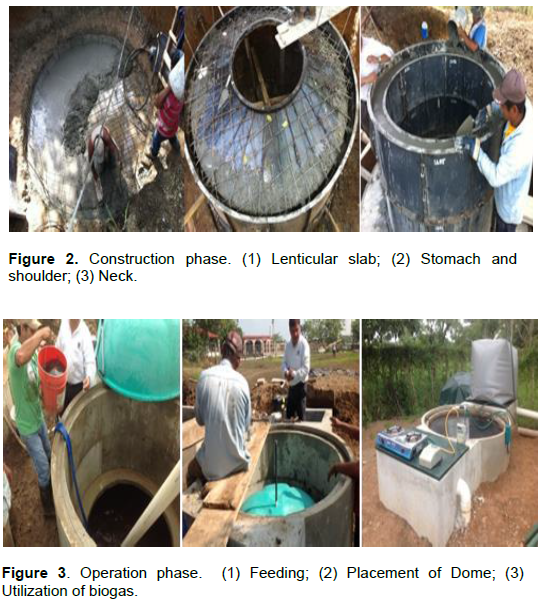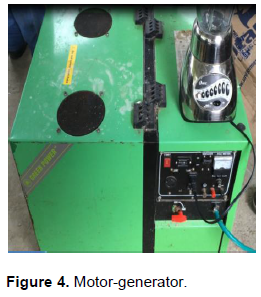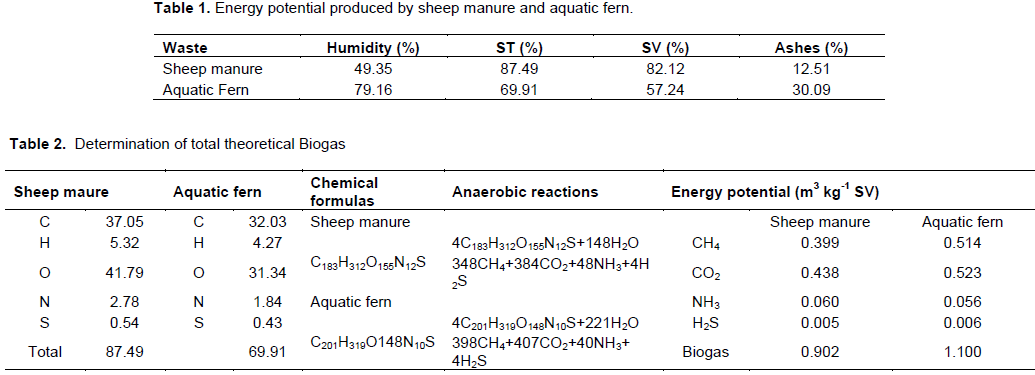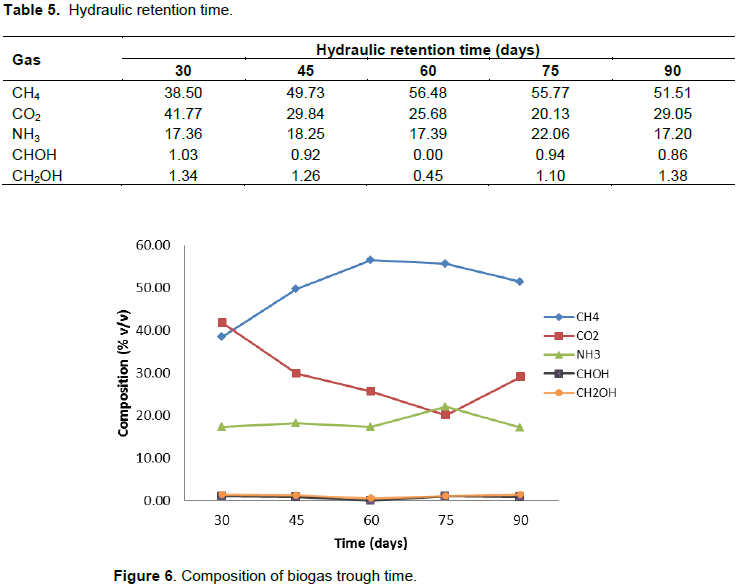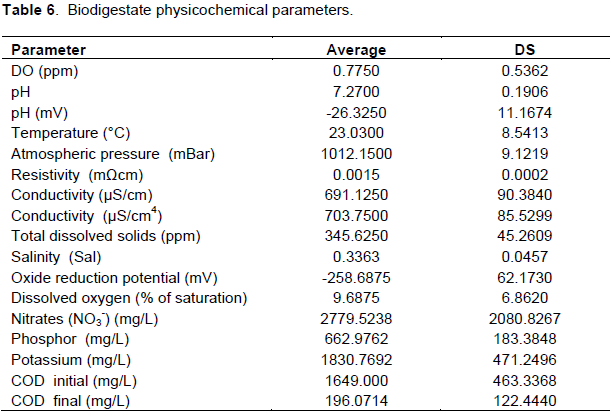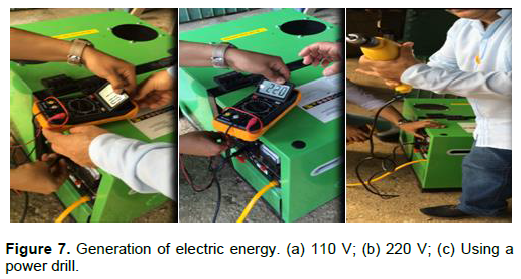ABSTRACT
Ranches of Mexico’s southeast region have an important energetic potential on their organic waste that remains unexploited. The objective of this work is to present the construction and operation of a floating dome “Biodigester” in a ranch located in Jalapa, Tabasco, Mexico, in addition to the analysis of produced biogas and its electric energy generation. The construction was based in the specifications of a Puxin® biogas plant. The biogas was analyzed using infra-red spectrometry with Fourier transforms. Electric energy was generated using an Energetic ® motor-generator. The methane and carbon dioxide percentage at 90 days of hydraulic retention time (HRT) was 51.51 and 29.05%, respectively. The electric energy generation was 3.58 kWhm-3.
Key words: Biomass, floating dome, energy, biodigestate, biogas.
In developing countries, particularly India and China, animal manure is used by farmers and the dairy industry to produce biogas, before manure is subject to other uses, such as fertilizers mostly. Anaerobic digestion is a biochemical process for organic matter degradation, by action of microorganisms under anaerobic conditions, resulting in products satisfying important needs of rural zones, such as biogas. Biogas for its heat potential and power generation, and digestate with a high content of nutrients applicable to crops (Asankulova, 2008; El-Mashad and Zhang, 2010; Fantozzi and Buratti, 2009; Fernández et al., 2010; Ferrer et al., 2011; Meng and Chung, 2010). In tropical zones, substrata with the highest potential for biogas production are water hyacinth (Eichhornia crassipes), manure (cattle, sheep, pork and poultry), cow gastric rumen content, yucca leaves, urban solid waste, agricultural wastes and residual water (Arthur et al., 2011; Krishna et al., 1991). Arthur et al. (2011) mention that sheep manure yield a return of 0.04 m3 kg-1 manure. Akbulut (2012) reports the generation of 5.5 kWh m-3, biogas quality was 55% of CH4, yielding with cow manure in combination with sheep maure (93.9 and 6.01%, accordingly). Aburas et al. (1996) state that biogas plants are more feasible in agricultural farms or ranch, particularly for isolated rural zones, away from the commercial electric networks, since they supply power for activities such cooking, heating and power generation. The also mention that a regular farm of approximately 2.3 ha (170 dairy cows, 20 veils and 2 bulls) have a daily requirement for light and motors consumption (water and charge) of 32.73 kWh-1, which may be supplied by 5 m3 of biogas, with a 67% content of methane, in a 16 m3 plant, and a production of 3.2 m3 day-1 of biogas. Mohseni et al. (2012) report that biogas is considered as a first generation fuel, because of the simplicity of the process to producing it, without specific chemical processes. What makes it attractive to users of this type of technology is its easy operation and maintenance, because there are very expensive and complex biogas plants, which are being rejected in rural zones. Arthur et al. (2011) stated that Puxin® biogas plant is a pressure digester and hydraulic seal, build with concrete and used in rural regions of India, where it has been widely accepted. A common activity in Mexico’s southeast ranches is to improperly dispose organic waste which causes water, soil and air pollution.
In Mexico’s southeast, the construction of anaerobic biodigestor is a practice that is just beginning to be developed. This work presents the construction and operation of a floating dome “Biodigester” in a ranch located in Mexico’s southeast, in addition to the analysis of produced biogas and its electric energy generation, which offers a sustainable option for farmers to dispose organic waste.
Biodigester construction
Puxin® adapted biogas plant is described in Figure 1. To build the 10 m3 Puxin® biogas plant, the following activities were performed:
Prospective view
A visit to “El Rodeo”, a ranch located in the municipality of Jalapa, in Tabasco, Mexico, was made to define, based on the land topography project functionality, the area where the biogas plant was built.
Site suitability
Works of site cleaning, stroke and leveling were completed. Later on an excavation of 4.00 × 4.00 × 3.00 m was made.
Reactor construction
A simple concrete base was built to receive the Biodigester structure: Before starting with the construction of the biogas plan, a F´c = 100 kg cm-2 concrete base was built with the purpose of isolating the foundation area from mud and water puddles, which may contaminate concrete when pouring it for the biodigester base.
Pouring biodigester structure:
1. Lenticular slab: An important part of the structure. From this section depends the structure works as a whole in a stable form. It is circular, 3.00 m in diameter. It was made out of F´c = 250 kgcm-2 concrete and reinforced with 6-6/4-4” electro-welded steel mesh. 3/8” steel bars were placed all around the perimeter, with 20 cm2 separation with the “stomach and shoulder”. The purpose of the steel bar is to join monolithically the slab, stomach, and shoulder (Figure 1).
2. Stomach and shoulder: The wood frame was set to hand the “stomach and shoulder”. Vegetable oil was used to facilitate separation. Inside the “stomach” wood frame, 3/8” steel bars were placed every 20 cm on the perimeter of the slab, in square shape (90°), with the purpose of tying together both sides of the biodigester (slab and stomach). The stomach and shoulder structure was built with F’c = 250 kgcm-2 concrete and reinforced with 6-6/ 4-4” electro-welded steel mesh. The final structure was built monolithically (Figure 2).
3. Neck: A wood frame was prepared to build the neck. F´c = 250 kgcm-2 concrete and reinforced with 6-6/ 4-4” electro-welded steel mesh was used, and was monolithically poured. On the top section of this structure, a flange was made to receive the dome that shall be the biodigester cap. (Figure 3).
4. Input and output of registers: On the biodigester shoulder, two 6” PVC tubes were attached in symmetric line, which shall be used as structures for feeding and releasing the biodigestate. Input and output tubes were cut at a length of 1.50 m and were placed with a separation of 0.50 m from the bottom of the biodigester. The measures of the inlet and outlet are 1.00 × 0.80 m, block walls,
matching its height at neck level.
5. Biogas plant finishing works: For internal finishing plaster of stomach and shoulder, a 1:12:1 mix (cement, sand and water respectively) was used. Once constructions activities of the biodigester were completed, soil from excavation was spread and flattened to field natural level.
6. Biodigestate reception cell: At output register, a pipe was adapted to lead “digestate” through a syphon to a digested liquids reception tank, with measurements 3.22 × 1.67 × 1.24 m and a volume of 5.31 m3. This particular system automatically sends exceeding liquids to a reception cell by means of gravity.
7. Mixer: A devise measuring 1.00 × 1.00 × 1.00 m and a volume of 1 m3 was built, with the purpose of mixing upstream substrata.
It is worth mentioning that structure reinforcement, implementation of the digestate reception tank and the uses of higher F’c were adaptations made during the construction of the biodigester.
Glass fiber dome: The dome used was fiber glass based with 6 mm thickness. It also counts with a 1” PVC biogas outlet. Three metal structures of a triangular shape were place in the basement, and triangular metal supports placed over the circumference of the dome base, in order to keep it suspended while gathering the biogas.
Biodegester operation
A total of 160 kg of substrata were introduced in the mixer (120 kg of sheep manure and 40 kg of aquatic fern (Salvinia molesta)). Forty liters of residual sludge from fish tanks as inoculum, plus more than 9800 L of water from a deep well (organic load rate of 11.14 kg SV m-3 day-1) (Figure 1). This mix was sent by gravity to the input register, slowly filling the stomach and the neck. The biogas outlet was intentionally left open to avoid the formation of air bubbles under the dome (Figure 2). Hydraulic retention time (HRT) exceeded 90 days. The first time the dome was fully filled with biogas, it was used in a Puxin® stove (Figure 3).
Substrata analysis
Humidity was determined (SCFI, 1985); total solids were calculated from the difference of 100% humidity (Mahar et al., 2012), volatile solids (SCFI, 2015) and ashes (SCFI, 1984). Also, the elemental analysis of carbon, hydrogen, oxygen, nitrogen and sulfur (Analyzer Perkin Elmer® model: PE 2400). The chemical equation for sheep excreta and water fern was calculated.
Biogas analysis
From the start date of the project, an analysis of generated biogas was completed every week in a 5 cm length gas cell with KBr windows, using the “transmittance” technique, in a Thermo Nicolet (Nexus 670-FTIR) spectrometer, equipped with a Deuterated Triglycine Sulfate (DTGS) detector. Spectrums of 64 sweeps average were gathered for each sample, at a spectral resolution of 4 cm-1, between 400 and 4000 cm-1intervals.
Biodigestate analysis
For the biodigestate, a Hanna® 9828 equipment was used to measure oxygen dissolved, pH, temperature atmospheric pressure, resistivity, conductivity, true conductivity, total dissolved solids, salinity, oxide reduction potential (REDOX) and oxygen dissolved (% of saturation) in the field; and in the laboratory, nitrogen, phosphor and potassium were measure with a HANNA® HI83225 equipment, as well as the chemical oxygen demand (COD) from the beginning to the end, with a HANNA® C99 equipment.
Electric energy generation
The theoretical estimation of electric energy generated was calculated based on the amounts of biogas produced by each substrata used. For this purpose the Akbulut (2012) and Dach et al. (2014) equations were adapted as follows:
An Energetic® power generation equipment was used, with a generation capacity of 4.2 kWh m-3 (Figure 4). A theoretical efficiency of 42% was taken, as reported by Dach et al. (2014).
Table 1 shows the substrata analysis of sheep manure and aquatic fern used in the process. Table 2 shows the values for carbon, hydrogen, oxygen, nitrogen and sulfur, as well as it chemical formula, anaerobic reaction and energy potential for sheep manure and aquatic fern.
Figure 5 shows infra-red spectrum of biogas from sheep manure, aquatic fern and residual sludge in fish tanks generated at the floating dome type plant located at “El Rodeo” ranch.
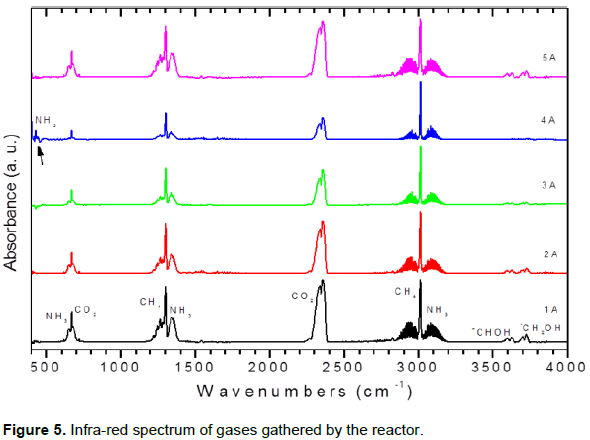
It also, shows the presence of two CH4 narrow bands. One corresponds to an active IR signal of 3019 cm-1 assigned to a stretch (triple degeneration) and the other to an active IR signal of 1306 cm-1 assigned to strain (triple degeneration). Along with these bands, two groups of very fine signals between 2800 a 3200 cm-1 are found; they correspond to the vibrations assigned to NH3. Another two bands also observe, which correspond to an active IR signal of 1391 cm-1 assigned to an asymmetric stretch (double degeneration) of NH3 and the other, of 530 cm-1, assigned to an asymmetric deformation (double degeneration). It can also be observed, a very small band all over spectrum 1A and 4A, corresponding to active IR signals of 450 cm-1 assigned to a symmetric deformation of NH3. Other bands observed in the spectrum are the ones corresponding to active IR of CO2 of 2349 cm-1, assigned to asymmetric stretch, and the active IR signals shown of 667 cm-1 assigned to a deformation out of the plane and deformation in the plane at the same frequency. It is also observed in the spectrums two double bands in the region of 3550 to 3750 cm-1 which correspond to primary alcohols -CH2OH and secondary alcohols = CHOH.
In the Table 4, are shown group frequencies for principal gases in the biogas.
Table 5 shows the percent composition of CH4, CO2, NH3, CHOH and CH2OH calculated based on the intensities of the absorbance bands. Each percentage concentration resulted from the ratio of the absorbance of each band divided by the total absorbance of all interferogram bands. Figure 6 shows how the methane values increase as the hydraulic retention time increases and the carbon dioxide values decrease as time passes.
Table 6 shows average values with their corresponding standard deviation of physicochemical parameters of biodigestate, measured in field and in laboratory.
Electric generation was determined from the generated theoretical biogas total value, 1.00 m3, applying the following equation:
After completing pilot tests using the electric generator, it was possible to achieve the generation of 110 and 220 V of energy, for 51.21 min, using 1 m3 of biogas (Table 7). The total generation of electric power was 3.58 kWh. Figure 7 shows the use of energy to start a power drill.
The organic load rate is much higher than the range reported by Álvarez and Lidén (2009) of 4 and 6 kg of SV m-3 day-1, however, the methane yield of 0.399 is higher than the range of 0.7 to 0.14 m3 kg-1 SV.
Regardless the season of the year, as Kalia and Kanwar (1998), Cantrell et al. (2008) mention, methanogen biogas production rate is sensitive to changes in influence material, pH, temperature, organic load velocity and hydraulic retention time (HRT), and they shall be controlled with the objective of maximizing the same biogas production.
Average temperature of the plant was always lower than environment temperature, as reported by Kalia and Kanwar (1998).
Mohammed et al. (2013) mention that organic compost from animals, is mostly treated by anaerobic digestion for energy production, and it is a product that may benefit farmers in different manners.
The FTIR provided reasonable precision with a root mean square error of 10% using partial least squares analysis (Hepburn et al., 2015).
A Puxin® adapted biogas plant, floating dome type works for the southeast of Mexico. The mixes of substrata used represent a new opportunity for energy conversion when treating livestock wastes for a benefitted center (Cantrell et al., 2008). A floating dome has been redesigned and a new element has been included for biodigestate gathering (reception cell), along with the modification in material proportions. It is important to continue working in the reduction of the hydraulic retention time (HRT) as Cantrell et al. (2008) mentions. Other substrata generated in farms must be considered. And also assess the technology using for instance the analytical hierarchical process, appointed by Rao et al. (2014). Muller et al. (2007) which mentions that taking biofuel at a farm scale offers a great opportunity for the agricultural sector to reduce their dependency from imported fossil fuels, and at the same time, soil, water and air quality improve. According to Mohammed et al. (2013) the (%) of biomass contribution rate around the world for a final energy consumption, where Latin America is positioned in an intermediate place with a 18.20%, in comparison with Africa (60%) and the Middle East (0.30%), showing that agricultural biomass exploitation is not properly used and must be supported by government and other interested parties, through a pertinent program of support and incentive provisions specifically for transferring the focus on resources such as forestry for other bio-energy wastes. Our current study indicates that we can use the mix of substrata; however, improvement in biogas quality and production is highly desirable, therefore further studies about different mix of substrate will be made. In addition, longer-term examinations will be continued on the efficacy of the best process to enrich the biogas and to produce electric energy.
The authors have not declared any conflict of interests.
REFERENCES
|
Aburas R, Hammad MA, Hiary SE, Qousous S, Abu-Reesh I (1996). Construction and Operation of a Demonstration Biogas Plant, Problems and Prospects. Energy Convers. Manag. 37(5):611-614.
Crossref
|
|
|
|
Akbulut A (2012). Techno-Economic Analysis of Electricity and Heat Generation from Farm-Scale Biogas Plant: Cicekdagi Case Study. Energy 44(1):381-390.
Crossref
|
|
|
|
|
Alvarez R, Gunnar L (2009). Low Temperature Anaerobic Digestion of Mixtures of Llama, Cow and Sheep Manure for Improved Methane Production. Biomass and Bioenergy 33(3):527-533.
Crossref
|
|
|
|
|
Arthur R, Martina FB, Edward A (2011). Biogas as a Potential Renewable Energy Source: A Ghanaian Case Study. Renew. Energy 36(5):1510-1516.
Crossref
|
|
|
|
|
Asankulova A (2008). Analysis of Factors Influencing Biogas Release. Appl. Sol. Energy 44(3):229-231.
Crossref
|
|
|
|
|
Cantrell KB, Thomas D, Kyoung SR, Patrick GH (2008). Livestock Waste-to-Bioenergy Generation Opportunities. Bioresour. Technol. 99(17):7941-7953.
Crossref
|
|
|
|
|
Dach J, Boniecki P, Przybyl J, Janczak D, Lewicki A, Czekala W, Witaszek K, Rodriguez PC, Cieslik M (2014). Energetic Efficiency Analysis of the Agricultural Biogas Plant in 250kWe Experimental Installation. Energy 69:34-38.
Crossref
|
|
|
|
|
El-Mashad HM, Zhang R (2010). Biogas Production from Co-Digestion of Dairy Manure and Food Waste. Bioresour. Technol. 101(11):4021-4028.
Crossref
|
|
|
|
|
Fantozzi F, Buratti C (2009). Biogas Production from Different Substrates in an Experimental Continuously Stirred Tank Reactor Anaerobic Digester. Bioresour. Technol. 100(23):5783-5789.
Crossref
|
|
|
|
|
Fernández J, Pérez M, Romero LI (2010). Kinetics of Mesophilic Anaerobic Digestion of the Organic Fraction of Municipal Solid Waste: Influence of Initial Total Solid Concentration. Bioresour. Technol. 101(16):6322-6328.
Crossref
|
|
|
|
|
Ferrer I, Garfí M, Uggetti E, Ferrer-Martí L, Calderon A, Velo E (2011). Biogas Production in Low-Cost Household Digesters at the Peruvian Andes. Biomass Bioenergy 35(5):1668-1674.
Crossref
|
|
|
|
|
Hepburn CA, Vale P, Brown AS, Simms NJ, McAdam EJ (2015). Development of on-line FTIR spectroscopy for siloxane detection in biogas to enhance carbon contactor management. Talanta 14:128-136.
Crossref
|
|
|
|
|
Housecroft C, Sharpe A (2008). Inorganic Chemistry, Third Edition.
|
|
|
|
|
Kalia AK, Kanwar SS (1998). Long-Term Evaluation of a Fixed Dome Janata Biogas Plant in Hilly Conditions. Bioresour. Technol. 65(1-2):61-63.
Crossref
|
|
|
|
|
Krishna N, Sumitra D, Viswanath P, Deepak S, Sarada R (1991). Anaerobic Digestion of Canteen Waste for Biogas Production: Process Optimisation. Process Biochem. 26(1):1-5.
Crossref
|
|
|
|
|
Laines JR, Aurelio SO (2013). Degradación Anaerobia Del Contenido Gástrico Ruminal Bovino Para La Obtención de Biogás, En Un Biodigestor Tipo Cúpula. Ingeniería, Revista Académica de La FI-UADY 17(1):57–65.
|
|
|
|
|
Mahar RB, Sahito AR, Uqaili MA (2012). Biomethanization Potential of Waste Agricultural Biomass in Pakistan: A Case Study. Int. J. Biomass Renew. Energy 1:32-37.
|
|
|
|
|
Meng Q, Chung DDL (2010). Battery in the Form of a Cement-Matrix Composite. Cement and Concrete Composites 32(10):829-39.
Crossref
|
|
|
|
|
Mohammed YS, Mokhtar AS, Bashir N, Saidur R (2013). An Overview of Agricultural Biomass for Decentralized Rural Energy in Ghana. Renew. Sustain. Energy Rev. 20:15-22.
Crossref
|
|
|
|
|
Mohseni F, Magnusson M, Görling M, Alvfors P (2012). Biogas from Renewable Electricity - Increasing a Climate Neutral Fuel Supply. Appl. Energy 90(1):11-16.
Crossref
|
|
|
|
|
Müller C (2007). Anaerobic Digestion of Biodegradable Solid Waste in Low- and Middle-Income Countries. Anaerobic Digestion of Biodegradable Solid Waste in Low- and Middle-Income Countries.pdf).
|
|
|
|
|
Rao B, Archana M, Anand BR, Vishal S (2014). Multi-Criteria Analysis of Alternative Biogas Technologies. Energy Procedia 54:292-301.
Crossref
|
|
|
|
|
Secretaria de Comercio y Fomento Industrial (1984). NMX-AA-018-1984 Proteccion Al Ambiente-Contaminacion Del Suelo- Residuos Solidos Municipales-Determinación de Cenizas.
|
|
|
|
|
Secretaria de Comercio y Fomento Industrial (1985). NMX-AA-016-1985 Proteccion Al Ambiente-Contaminacion Del Suelo- Residuos Solidos Municipales-Determinación de Humedad.
|
|
|
|
|
Secretaria de Comercio y Fomento Industrial (2015). NMX-AA-034-SCFI-2015 Análisis De Agua - Medición De Sólidos Y Sales Disueltas En Aguas Naturales , Residuales Y Residuales Tratadas – Método De Prueba (Cancela a La Nmx-AA-034-SCFI-2001 ). .
|
|
|
|
|
Stine K (1975). Beckman Laboratory Manual. Beckman Instruments.
|
|

